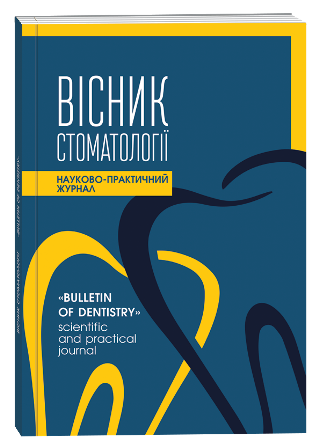OPTIMIZATION OF PERIODONTAL TREATMENT AND ORTHOPEDIC RESTORATION OF DENTITION DEFECTS IN MILITARY PERSONNEL AND VETERANS (LITERATURE REVIEW)
DOI:
https://doi.org/10.35220/2078-8916-2025-55-1.21Keywords:
military personnel, combatants, veterans, periodontal diseases, generalized periodontitis, oral hygiene, Stress, Risk Factors, periodontal treatment, dental splinting, orthopedic restoration of dentition defectsAbstract
Purpose of the study. The current level of ensuring the defense capability of any country imposes increased requirements on the state of Health and professional reliability of military personnel. At the same time, oral health in military personnel is considered a key indicatorthat affects the overall state of health, performance ofduties, well-being and quality of life. Military personnel represent a unique cohort with special oral health problems due to their special lifestyle, occupational risks, and limited access to dental care. To optimize periodontal treatment and orthopedic restoration of dentition defects in militarypersonnel and veterans, an analysis of scientific sources ofliterature on this topic was carried out. Literature sources from the scientometric electronic databases PubMed, Medline, Scopus, and Google Scholar are analyzed.Taking into account the large number of articles and thedesire to present up-to-date scientific data, 64 articles wereselected. Research methods. Our article describes thefeatures of the profile of risk factors for the developmentof generalized periodontal tissue diseases, dentition defects in military personnel and veterans, and modern approaches to treatment. In recent years, the evidence base for splinting mobile teeth and orthopedic restorationof patients with dentition defects has increased. Furtherresearch is needed to better understand the effectivenessof these interventions and justify their use in military personnel and veterans. Conclusions. Military personnel belong to the group with a high risk of developing oral diseases, in particular generalized periodontal diseases, due to intense and severe physical and psychological stress, stress, the nature of nutrition, limited access to dental care during military training and combat operations. However, the direct impact of these risk factors for the development or progression of generalized periodontitis in military personnel remains poorly understood. Tooth mobility caused by the destruction of the supporting structures of the tooth is one of the main clinical symptoms of generalized periodontitis. The proposed methods of splinting mobileteeth are effective, but require further improvement andstudy of long-term results.
References
Lloro V., Lozano de Luaces V., Lloro I., Manzanares M.C. The incidence of dental needs during isolated missions compared to non-isolated missions : a systematic review and implications for future prevention strategies. Mil Med. 2019. № 184 (3–4). P. e148–155. doi: 10.1093/ milmed/usy364.
Armstrong S., Dermont M. Defence dentistry: an occupationally focused health service with world- wide deployable capability. Br Dent J. 2021. № 230 (7). P. 417–423. doi: 10.1038/s41415-021-2834-1.
Horning G.M., Hatch C.L., Lutskus J. The prevalence of periodontitis in a military treatment population. J Am Dent Assoc. 1990. № 121 (5). P. 616–622. doi: 10.14219/jada.archive.1990.0221.
Amaliya A., Pribadi S., Akbar Y.M., Sitam S. Peri- odontal disease: a rise in prevalence in military troops penyakit periodontal. Odonto Dental J. 2021. № 8 (1). P. 6–17.
Kaniura O.A., Bidenko N.V., Kolenko Yu.H, Filonenko V.V., Khrol N.S., Shpak D.Iu. Experience of providing dental care in the conditions of the military state. Actual Dentistry. 2022. № № 3–4. P. 38–44. doi: 10.33295/1992-576X-2022-3-38.
Bilan V.O., Bandrivskyi Yu.L. Index assessment of the periodontal tissue condition in military personnel of the Ukrainian armed forces with inflammatory and dystrophic-inflammatory diseases of periodontal tissues depending on their stress resistance and level of reactive anxiety. Ukrainian Dental Almanac. 2024. № 2. P. 5–10. doi: 10.31718/2409-0255.2.2024.01.
Mombiedro Sandoval R., Llena Puy R. Periodontal status and treatment needs among Spanish military personnel. Med Oral Patol Oral Cir Bucal. 2008. № 13 (7). P. E464–9.
Dunn W.J., Langsten R.E., Flores S., Fandell J.E. Dental emergency rates at two expeditionary medical sup- port facilities supporting operations enduring and Iraqi Freedom. Mil Med. 2004. № 169 (7). P. 510-4. doi: 10.7205/milmed.169.7.510.
Richardson P.S. Dental morbidity in United Kingdom Armed Forces, Iraq 2003. Mil Med. 2005. № 170 (6). P. 536–41. doi: 10.7205/milmed.170.6.536.
Combes J., Pepper T., Bryce G., MacBeth N. Dental care provision to UK military personnel serving on Operation Herrick in Afghanistan. Part 2 : Etiology and management. Br Dent J. 2019. № 226 (1). P. 50–54. doi: 10.1038/sj.bdj.2019.7.
Preshaw P.M., Alba A.L., Herrera D., Jepsen S., Konstantinidis A., Makrilakis K. et al. Periodontitis and diabetes: a two-way relationship. Diabetologia. 2012. Jan. № 55 (1). P. 21–31. doi: 10.1007/s00125-011-2342-y.
Baiju R.M., Peter E., Varghese N.O., Sivaram R. Oral health and quality of life: Current concepts. J Clin Diagn Res. 2017. № 11 (6). P. ZE21 – ZE26. doi: 10.7860/ JCDR/2017/25866.10110.
Suman M., Spalj S., Plancak D., Dukic W., Juric H. The influence of war on the oral health of professional soldiers. Int Dent J. 2008. № 58 (2). P. 71–74. doi: 10.1111/j.1875-595x.2008.tb00178.x.
Wörner F., Eger T., Simon U., Wolowski A. Periodontal disease and tooth wear in a sample of German soldiers with posttraumatic stress disorder. Oral Health Prev Dent. 2021. № 19. P. 449–456. doi: 10.3290/j.ohpd. b1993989.
Tonetti M.S., Greenwell H., Kornman K.S. Staging and grading of periodontitis: Framework and proposal of a new classification and case definition. J Clin Periodontol. 2018. № 45, 20. P. S149–61. doi: 10.1111/jcpe.12945.
Highfield J. Diagnosis and classification of periodontal disease. Aust Dent J. 2009. № 54, 1. P. S11–26. doi: 10.1111/j.1834-7819.2009.01140.x.
Donos N. The periodontal pocket. Periodontol 2000. 2018. № 76 (1). P. 7–15. doi: 10.1111/prd.12203.
Newbrun E. Indices to measure gingival bleeding. J Periodontol. 1996. № 67 (6). P. 555–61. doi: 10.1902/ jop.1996.67.6.555.
Tagger-Green N., Nemcovsky C., Gadoth N., Cohen O., Kolerman R. Oral and dental considerations of combat-induced PTSD: a descriptive study. Quintessence Int. 2020. № 51 (8). P. 678–685. doi: 10.3290/j.qi.a44809.
Coelho J.M.F., Miranda S.S., Da Cruz S.S., Trindade S.C., Passos-Soares J.S., Cerqueira E.M.M. et al. Is there association between stress and periodontitis? Clin Oral Investig. 2020. № 24 (7). 2285–94. doi: 10.1007/ s00784-019-03083-9.
Tagger-Green N., Nemcovsky C., Fridenberg N., Green O., Chaushu L., Kolerman R. Oral and dental considerations of combat-induced post traumatic stress disorder (PTSD)-A cross-sectional study. J Clin Med. 2022. № 11 (11). P. 3249. doi: 10.3390/jcm11113249.
Macrì M., D’Albis G., D’Albis V., Antonacci A., Abbinante A., Stefanelli R. et al. Periodontal health and its relationship with psychological stress : A Cross-sectional study. J Clin Med. 2024. № 13 (10). P. 2942. doi: 10.3390/ jcm13102942.
Levin L., Baev V., Lev R., Stabholz A., Ashkenazi M. Aggressive periodontitis among young Israeli army personnel. J Periodontol. 2006. № 77 (8). P. 1392–6. doi: 10.1902/jop.2006.050323.
Lloro V., Lozano-de Luaces V., Lloro I., Manzanares M.C. The incidence of dental needs during isolated missions compared to non-isolated missions : A systematic review and implications for future prevention strategies. Mil Med. 2019. № 184 (3–4). P. e148–55. doi: 10.1093/ milmed/usy364.
Lertpimonchai A., Rattanasiri S., Arj-Ong Vallibhakara S., Attia J., Thakkinstian A. The association between oral hygiene and periodontitis: a systematic review and meta-analysis. Int Dent J. 2017. № 67 (6). P. 332–43. doi: 10.1111/idj.12317.
Skec V., Macan J.S., Susac M., Jokić D., Brajdić D., Macan D. Influence of oral hygiene on oral health of recruits and professionals in the Croatian Army. Mil Med. 2006. № 171 (10). P. 1006–9. doi: 10.7205/milmed.171.10.1006.
Bárcena García M., Cobo Plana J.M., Rodríguez Cagiao G., Arcos González P.I. Epidemiological methods used in the periodontal health research in military personnel : a systematic review. BMJ Mil Health. 2024. № 170 (1). P. 72–7. doi: 10.1136/bmjmilitary-2021-001977.
Fayaz Y., Ahmadi N.A., Ahmadi S.U., Atiq M.A. Common reasons for permanent tooth extraction and its correlation with demographical factors in Kabul, Afghanistan. Clin Cosmet Investig Dent. 2024. № 16. P. 25–31. doi: 10.2147/CCIDE.S442179.
Gerritsen A.E., Allen P.F., Witter D.J., Bronkhorst E.M., Creugers N.H. Tooth loss and oral health-related quality of life: a systematic review and meta-analysis. Health Qual Life Outcomes. 2010. № 8. P. 126. doi: 10.1186/1477-7525-8-126.
Papapanou P.N., Sanz M., Buduneli N., Dietrich T., Feres M., Fine D.H. et al. Periodontitis: Consensus report of workgroup 2 of the 2017 World Workshop on the classification of periodontal and peri-implant diseases and conditions. J Periodontol. 2018. № 89, 1. P. S173–82. doi: 10.1002/JPER.17-0721.
Sonnenschein S.K., Kilian S., Ruetters M., Ciardo A., Kim T.S. Changes in periodontal parameters of splinted versus non-splinted posterior teeth during ten years of supportive periodontal therapy – A retrospective evaluation. Clin Oral Investig. 2024. № 28 (5). P. 283. doi: 10.1007/s00784-024-05679-2.
Sonnenschein S.K., Ziegler P., Ciardo A., Ruetters M., Krisam J., Kim T.S. The impact of splinting mobile mandibular incisors on Oral Health-Related Quality of Life-Preliminary observations from a randomized clinical trial. J Clin Periodontol. 2021. № 48 (6). P. 816–25. doi: 10.1111/jcpe.13454.
Kathariya R., Devanoorkar A., Golani R., Shetty N., Vallakatla V., Bhat M.Y. To splint or not to splint: The cur- rent status of periodontal splinting. J Int Acad Periodontol. 2016. № 18 (2). P. 45–56.
Jepsen S., Caton J.G., Albandar J.M., Bissada N.F., Bouchard P., Cortellini P. et al. Periodontal manifestations of systemic diseases and developmental and acquired conditions: Consensus report of workgroup 3 of the 2017 World Workshop on the Classification of Periodontal and Peri-Implant Diseases and Conditions. J Periodontol. 2018. № 89, 1. P. S237–48. doi: 10.1002/JPER.17-0733.
Kim G.Y., Kim S., Chang J.S., Pyo S.W. Advancements in methods of classification and measurement used to assess tooth mobility : A narrative review. J Clin Med. 2023. № 13 (1). P. 142. doi: 10.3390/jcm13010142.
Sonnenschein S.K., Ciardo A., Kilian S., Ziegler P., Ruetters M., Spindler M. et al. The impact of splinting timepoint of mobile mandibular incisors on the outcome of periodontal treatment-preliminary observations from a randomized clinical trial. Clin Oral Investig. 2022. № 26 (1). P. 921–30. doi: 10.1007/s00784-021-04075-4.
Busato A.S., González P.A.H., Camilo E.M., De Deus M.N. Alternative treatment for teeth with substitutive root resorption. ROBRAC. 2000. № 9 (27), P. 18–23.
Mosedale R.F. Current indications and meth- ods of periodontal splinting. Dent Update. 2007. № 34 (3). P. 168–170, 173–174, 176–178. doi: 10.12968/ denu.2007.34.3.168.
Veras S.R.A., Bem J.S.P., De Almeida E.C.B., Lins C.C.D.S.A. Dental splints: types and time of immobilization post tooth avulsion. J Istanb Univ Fac Dent. 2017. № 51. P. S69–75. doi: 10.17096/jiufd.93579.
White I., Spiers G. Taking the trauma out of trauma: an easy to follow guide for the management of trauma to the permanent dentition. Dent Update. 2013. № 40 (8). P. 643–644, 647–648, 650–652 passim. doi: 10.12968/ denu.2013.40.8.643.
Su N., van Wijk A., Visscher C.M. Psychosocial oral health-related quality of life impact : A systematic review. J Oral Rehabil. 2021. № 48 (3). P. 282–292. doi: 10.1111/joor.13064.
Graetz C., Ostermann F., Woeste S., Sälzer S., Dörfer C.E., Schwendicke F. Long-term survival and maintenance efforts of splinted teeth in periodontitis patients. J Dent. 2019. № 80. P. 49–54. doi: 10.1016/j. jdent.2018.10.009.
Kumbuloglu O., Saracoglu A., Ozcan M. Pilot study of unidirectional E-glass fibre-reinforced composite resin splints: up to 4,5-year clinical follow-up. J Dent. 2011. № 39 (12). P. 871–7. doi: 10.1016/j.jdent.2011.09.012.
Sekhar L.C., Koganti V.P., Shankar B.R., Gopi- nath A. A comparative study of temporary splints: bonded polyethylene fiber reinforcement ribbon and stainless steel wire + composite resin splint in the treatment of chronic periodontitis. J Contemp Dent Pract. 2011. № 12 (5). P. 343–349. doi: 10.5005/jp-jour- nals-10024-1057.
Shin H.J., Kim H., Moon W., Song J.S., Hyun H.K. Color stability and translucency of newly developed com- posites for splinting teeth. Dent Mater J. 2024. № 43 (3), P. 437–445. doi: 10.4012/dmj.2023-257.
Alkan A., Aykaç Y., Bostanci H. Does temporary splinting before non-surgical therapy eliminate scaling and root planing-induced trauma to the mobile teeth? J Oral Sci. 2001. № 43 (4). P. 249–54. doi: 10.2334/josnusd.43.249.
Forabosco A., Grandi T., Cotti B. The importance of splinting of teeth in the therapy of periodontitis. Minerva Stomatol. 2006. № 55 (3). P. 87–97.
Agrawal A.A., Chitko S.S. The use of silane-coated industrial glass fibers in splinting periodontally mobile teeth. Indian J Dent Res. № 22 (4). P. 594–596. doi: 10.4103/0970-9290.90307.
Zhang Y., Kang N., Xue F., Duan J., Chen F., Cai Y. et al. Survival of nonsurgically splinted mandibular anterior teeth during supportive maintenance care in periodontitis patients. J Dent Sci. 2023. № 18 (1). P. 229–36. doi: 10.1016/j.jds.2022.05.025.
Machtei E.E., Hirsch I. Retention of hopeless teeth: the effect on the adjacent proximal bone following perio- dontal surgery. J Periodontol. 2007. № 78 (12). P. 2246–52. doi: 10.1902/jop.2007.070125.
Dommisch H., Walter C., Difloe-Geisert J.C., Gintaute A., Jepsen S., Zitzmann N.U. Efficacy of tooth splinting and occlusal adjustment in patients with periodontitis exhibiting masticatory dysfunction : A systematic review. J Clin Periodontol. 2022. № 49, 24. P. 149–66. doi: 10.1111/ jcpe.13563.
Puri M.S., Grover H.S., Gupta A., Puri N., Luthra S. Splinting–A healing touch for an ailing periodontium. J Oral Health Comm Dent. 2012. № 6 (3). P. 145–8.
Sobczak-Zagalska H., Emerich K. Best splinting methods in case of dental injury-A literature review. J Clin Pediatr Dent. 2020. № 44 (2). P. 71–78. doi: 10.17796/1053-4625-44.2.1.
Kahler B., Hu J.Y., Marriot-Smith C.S., Heithersay G.S. Splinting of teeth following trauma: a review and a new splinting recommendation. Aust Dent J. 2016. № 61. 1. P. 59–73. doi: 10.1111/adj.12398.
Jamal S., Motiwala M.A., Ghafoor R. Conventional and contemporary approaches of splinting traumatized teeth : A review article. J Pak Med Assoc. 2020. № 70 (2). P. S53–9.
Liu Y., Fang M., Zhao R., Liu H., Tian M., Zhong S. et al. Effects of periodontal splints on biomechanical behaviors in compromised periodontal tissues and cement layer: 3D finite element Analysis. Polymers (Basel). 2022. № 14 (14). P. 2835. doi: 10.3390/ polym14142835.
Bernal G., Carvajal J.C., Muñoz-Viveros C.A. A review of the clinical management of mobile teeth. J Contemp Dent Pract. 2002. № 3 (4). P. 10–22.
Liddelow G., Carmichael G. The restoration of traumatized teeth. Aust Dent J. 2016. № 61. 1. P. 107–19. doi: 10.1111/adj.12402.
AlSaggaf A.U., Alqutub A., Almasri Z., Khalifah F., Khuzaee F., Aljuaid A. et al. Oral health-related quality of life improvement after treatment with fixed and removable dental prostheses. Cureus. 2024. № 16 (10). P. e71013. doi: 10.7759/cureus.71013.
Arocha M.A., Basilio J., Llopis J., Di Bella E., Roig M., Ardu S. et al. Colour stainability of indirect CAD-CAM processed composites vs. conventionally laboratory processed composites after immersion in staining solutions. J Dent. 2014. № 42 (7). P. 831–8. doi: 10.1016/j. jdent.2014.04.002.
Yeslam H.E. Freifrau, von Maltzahn N., Nassar HM. Revolutionizing CAD/CAM-based restorative dental processes and materials with artificial intelligence : a concise narrative review. Peer J. 2024. № 12. P. e17793. doi: 10.7717/peerj.17793.
Liu Y., Bai S., Zhong S., Liu H., Tian M., Niu L. et al. Digital workflow for periodontal splinting with a guided device. J Esthet Restor Dent. 2023. № 35 (4). P. 621–624. doi: 10.1111/jerd.13026.
Shi X., Zhan Y., Liu F. A digital way for fabricating a resin-bonded fixed partial denture combined with periodontal splint in the mandibular anterior region. Biomed Res Int. 2022. P. 6254551. doi: 10.1155/2022/6254551.
Li J., Jiang T., Lv P., Fang X., Xiao Z., Jia L. Four-year clinical evaluation of gfrc-rbfpds as periodontal splints to replace lost anterior teeth. Int J Prosthodont. 2016. № 29 (5). P. 522–7. doi: 10.11607/ijp.4845.









